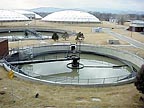
A recent on-line survey of water treatment professionals found that most treatment facilities continue to use chlorine as the primary disinfectant, despite some pressure to consider alternative options.
The Chlorine Chemistry Council (CCC) surveyed 52 public health and drinking water utility officials nationwide to gauge opinions about the use of chlorine in drinking water disinfection. While most facilities continue to rely on chlorine-based disinfectants, results show that outside pressures, such as government regulations, have raised the visibility of alternative methods of disinfection.
The CCC distributed the survey to over 350 professionals around the country, representing utilities of varying size. Not a scientific study by nature, the sample of individuals was selected through an Internet search of major utilities throughout the country. Over the course of two weeks, the survey netted a 14.5 percent rate of return - a considerably high rate for a survey, particularly one conducted on-line.
Disinfection Methods
All of the surveyed water treatment plants reported to use some form of chlorine as the primary method of disinfection. The majority (54%) use chlorine gas as their primary disinfectant. Other forms of chlorine the officials indicate using include sodium or calcium hypochlorite (29%), chloramines (13%) and chlorine dioxide (4%).
Primary disinfection inactivates microbial pathogens at the water treatment plant, while secondary disinfectants are added to ensure adequate residual disinfection throughout the water distribution system. Twenty-seven percent of the participants indicate using secondary forms of disinfection, which include chloramines and chlorine dioxide to name a few.
Considering the Options
The majority of water treatment professionals choose chlorine as their primary disinfectant, but their decisions are not made without external pressure to consider adopting alternative methods. While most (87%) participants have not switched - and do not plan to switch - a significant number (40%) of the officials indicate having felt pressure to stop using chlorine products as a primary disinfectant. And the pressures come from a variety of sources.Government regulations regarding acceptable levels of disinfection byproducts (DBPs) as well as safety regulations account for most (36%) of the pressure that water treatment facilities face when considering primary disinfectants, closely followed by companies promoting alternative methods (23%) and customers' concerns (19%). In September 2000, the EPA and various stakeholders signed the Stage 2 Microbial and Disinfection Byproducts Federal Advisory Committee Agreement in Principle, which addressed drinking water regulations with a focus on both microbial pathogens as well as DBPs. In accordance with the agreement, the allowable level of DBPs was reduced to 80 parts per billion.
As water treatment facilities are pressured to consider alternatives, the public also is receiving information on DBPs from a variety of sources. When asked which sources play a role in creating anti-chlorine sentiments in the United States, officials cite activist organizations (47%), government regulations (23%), the media (14%) and companies promoting alternative methods (12%) as the loudest voices in the DBP debate.
Of the survey participants who switched to alternate primary disinfection methods (13%), government regulations are a factor that influenced about half (49%) of the group. One survey participant asserts the “primary directive comes from regulations - we really don't hear much apprehension from our customers.” Another adds, “The driving force for alternative disinfectant methods is the requirement for reduction of disinfectant byproducts as mandated by the Disinfec-tant/Disinfectant Byproduct Rule. Chlorine still is the only residual disinfectant available that is economically feasible.”
Research Findings
According to the survey results, chlorine-based products remain the most widely used disinfectants by water treatment professionals, largely due to their effectiveness, cost and residual properties. However, water professionals are facing pressures on two fronts - (1) EPA regulations lowering the allowable level of DBPs and (2) constituent concerns as a result of regulations, activist groups and media reporting. These pressures require water professionals to continually review disinfection practices and communicate to the public on the benefits and risks associated with disinfection.The survey provided a valuable opportunity for participants to offer personal comments. According to one participant, “We are required by state regulations to add chlorine/chloramines to the water at the point of entry into the distribution system and to ensure that there is still a residual at the far ends of our system.” Chlorine-based disinfectants are the only major disinfectants containing long-lasting residual properties to prevent microbial re-growth throughout the distribution process.
In part due to pressure from government regulations, many water treatment plants have switched from chlorine gas to chloramines - chlorine mixed with ammonia. To the water treatment officials, chloramines are an increasingly attractive option for controlling DBP levels. Utilities in cities such as Denver, Miami, Philadelphia and Los Angeles have begun using chloramines as the primary disinfectant. n
The majority of water treatment utilities use some form of chlorine as their primary disinfectant. ND
Report Abusive Comment